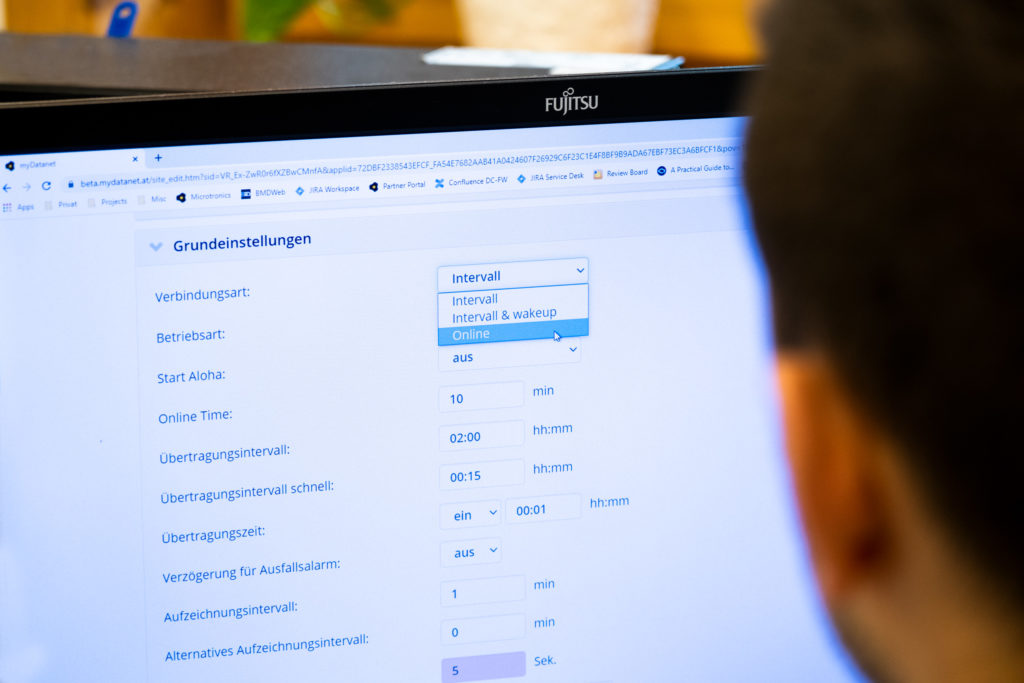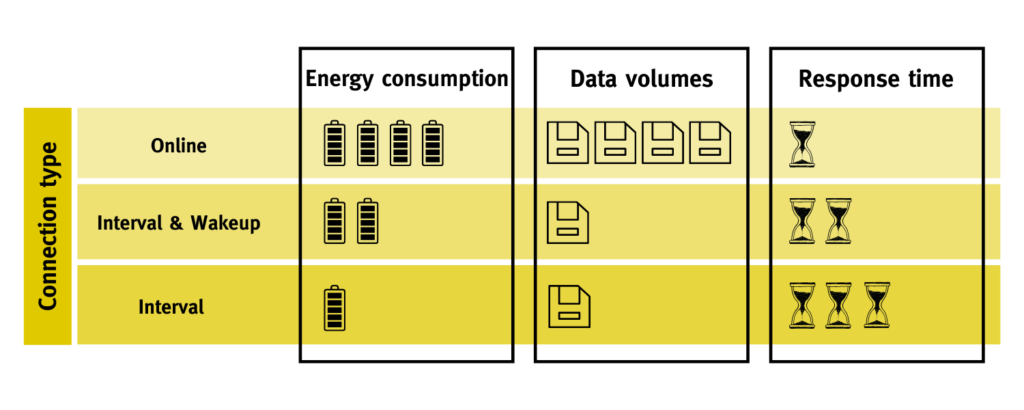Right away: there is no better or worse mode! Each has certain properties that fit better or worse depending on the application situation.
Let’s start with the Tec Basics!
A distinction is made between data recording and data transmission/data synchronisation.
During data recording, a data record, for example the measured values of sensors, is provided with the current time (time stamp) and stored in the device. No connection to the server is required at the time of recording. The data is temporarily stored on the device.
For data recording, the clear recommendation is: “As much as necessary, as little as possible”. This is because storing the data ties up resources on the device. Special memory chips (flash) are used for this purpose. Flash memories have the characteristic that write accesses are slow and energy-intensive. In return, the data is retained even in a de-energised state.
At the server, the data of all assigned devices must be stored in a database. The more devices and data, the more resources (e.g. hard disk space for the database) are needed. In addition, the transmission of data on the uplink interface ties up resources. In mobile communications, this leads to costs depending on the SIM tariff.
During data transmission, the data stored in the device is synchronised with the platform – server on the Internet, hereinafter referred to by the abbreviated form server.
Synchronisation takes place bidirectionally, that means
- data (for example, measured values) in the unit are transmitted to the server.
- Data (for example, configurations) are transferred from the server to the device.
Depending on the selected technology, the corresponding uplink module in the device is used for communication. This includes mobile modem, WiFi module or similar. In the following, only the term modem will be used for the sake of simplicity.

Modus INTERVAL / TRIGGERED
For this mode, the modem is only switched on when needed at the time of transmission or synchronisation. The less frequently the transmission takes place and the less data is to be transmitted, the lower the energy consumption.
Don’t worry, data that is once on the server is permanently available afterwards. The data on the device is organised in a ring memory, the oldest data is always overwritten. The size of the ring buffer depends on the device and can be found in the manual.
Changed configurations are only adopted in the course of data synchronisation at the device.
Modus ONLINE
The device automatically connects to the server and maintains thedata connection permanently. As soon as data is recorded, it is transmitted to the server. As soon as a configuration or control information is changed on the server, it is transmitted to the device. So the speed of reaction is the big advantage here.
This advantage is offset by the energy consumption as a disadvantage, as the modem in the device remains permanently switched on.
Modus WAKEUP
The modem is permanently switched on, but without a permanent data connection with the server. The device can bewoken up by the server and then automatically starts a synchronisation process. The energy consumption is higher than in INTERVAL mode, but lower than in ONLINE mode.
WAKEUP is technically realised via SMS. This mode can therefore only be used on devices with mobile phone uplink and SMS service – SIM and mobile phone provider. For modern mobile radio technologies, such as LTE-M, NB-IoT, it is currently very uncertain whether universal SMS support (all providers worldwide) will also be guaranteed in the future.
Microtronics recommends…
For battery- and accumulator-operated data loggers, the INTERVALL mode has proven itself, in which data is recorded hourly or several times an hour and transmitted one to a few times a day.
For permanently supplied devices that, in addition to data acquisition, also have to accept control information from the server, such as the command “open the gate”, the ONLINE mode is suitable.
Due to the free programmability of the IoT app in the rapidM2M Studio, various combination variantsare possible. For example, a data logger application can be designed that has a special commissioning mode. For the time of commissioning, the application uses the ONLINE mode. In this way, configurations are sent directly to the device. The recorded data is sent directly to the server and you can immediately see whether the application is behaving as desired. The application then switches to the standard mode (for example INTERVALL with data recording every 15 minutes and daily transmission). For permanent operation, INTERVALL mode is much more energy and resource efficient.

A glance into the future
In mobile communications, technology for the M2M/IoT sector has evolved towards LTE-M and NB-IoT. Support from network providers is already well advanced – see Mobile IoT Deployment Map. Diese Technologien bieten unter anderem umfangreiche Möglichkeiten für die Energieoptimierung der Kommunikation (eDRX und PSM). In order to use these functions, the modem, the SIM used and the mobile phone provider must be supported. It is therefore possible that different behaviour occurs depending on the network provider, for example provider A supports PSM, provider B does not.
We are staying on the ball to make these technologies as easy and efficient to use as possible in the future. High reaction speed combined with low energy consumption will remain a significant criterion for IoT applications in the future.
